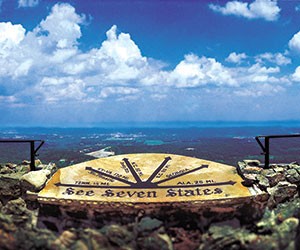From the old growth forests of the ancient Great Smoky Mountains and the heights of Lookout Mountain as it stands guard over the Chattanooga Valley to the depths of some of the nation’s most awe-inspiring caves, East Tennessee is home to many natural wonders. These one-of-a-kind attractions will have attendees’ eyes popping and also make great backdrops for alfresco dining.
Known for its abundant waterfalls, wildflowers and historic log buildings, Great Smoky Mountains National Park (865.436.1200; www.nps.gov/grsm) is the most visited national park in the country. The park boasts striking panoramas, especially during a sunrise or sunset over the fog-enshrouded hills. There are two entrances on the Tennessee side, in Gatlinburg and Townsend. The majestic, heavily forested mountains host several picnic pavilions seating 70, and many are open year-round.
Along the banks of the Tennessee River in Chattanooga, Ruby Falls (423.821.2544; www.rubyfalls.com) is a limestone wonder carved out deep beneath Lookout Mountain. Visitors can feast their eyes on fantastic cave formations and a 145-foot waterfall. Ruby Falls can welcome groups as large as 110 for private rentals. Zip line tours are also available at the attraction, and both the cave tour and zip lines offer discounts for groups of 15 or more. Catered group meals are available.
Rock City Gardens (706.820.2531; www.seerockcity.com), located atop Lookout Mountain just six miles across the Georgia border from Chattanooga, is home to 14 acres of spectacular rock formations, caves and landscaped gardens. This award-winning attraction is certified green by Tennessee Green Hospitality. Frequent festivals and live music performances make visits even more special. Discounts are available for groups of 15 or more, and the venue welcomes group picnics and buffet banquets.
America’s largest underground lake, the Lost Sea (423.337.6616; www.thelostsea.com), is situated in Sweetwater about halfway between Chattanooga and Knoxville. The basic tour includes a guided walk through the main caves and a glass-bottom boat ride on the lake. Groups can also opt for the “flashlight tour” extension to view undeveloped sections of the cave system. Twelve or more can take the “wild cave tour,” which has groups crawling through cracks to view rare anthodites, or cave flower formations, and hear fascinating tales of the cave’s history as a bootlegger’s hideout.



